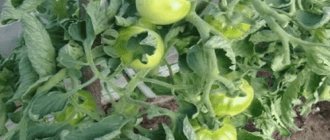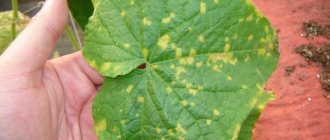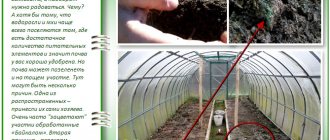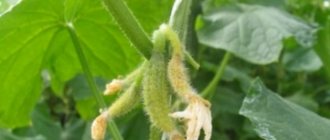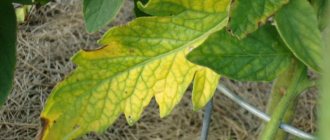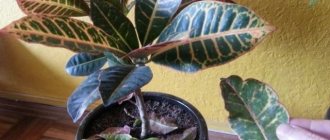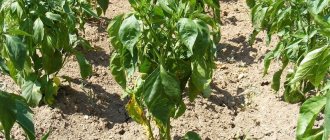Tomatoes have one interesting feature - a change in the shape of the leaf blade. During the heat of the day, it curls, thereby reducing the evaporation of moisture. With the onset of evening and after watering, the leaves acquire their normal original shape to absorb a new charge of water. Sometimes this phenomenon occurs due to varietal characteristics. If both options are excluded, then the cause may be a disease or a violation of crop cultivation technology. The gardener needs to find out why the leaves of tomatoes curl upward and take measures to save them.
What causes the pathology?
The main reasons why tomato leaves curl in a greenhouse
- The root system is damaged when transplanting seedlings into a greenhouse.
- Excessively active fertilizer, as a result of which there is an excess of microelements and minerals.
- Insufficient quality feeding, which results in a shortage of necessary elements.
- Too much or, on the contrary, scanty watering.
- Incorrect execution of pinching and pinching.
- Uncomfortable temperature in the greenhouse (an overly warm atmosphere is especially dangerous).
- Infection of the plant with various diseases.
- Damage by garden pests.
The most dangerous situation is when leaf curling is caused by several reasons. In this case, it is quite difficult to treat tomatoes.
Below is a more detailed description of each of the reasons and tips for improving the condition of tomatoes. It is recommended that you carefully read this paragraph of the article in order to be aware of what can lead to a deterioration in the condition of the seedlings.
Mechanical damage
While weeding and loosening with a hoe, the vegetable grower accidentally damages the surface roots of the tomatoes. The plant reacts by curling its leaves. To maintain tomatoes, water them with “Kornevin”, “Kornerost” or another stimulating drug.
Belated breaking off of the stepsons, when their length exceeds 5 cm, injures the plant, to which it also reacts by twisting the foliage. The plantings are revived by spraying with the preparation “Zircon”.
The last reason why tomato leaves curl upward may be disease or pest damage. For stolbur, bushes are treated with “Phytoplasmin”, and bacterial cancer is treated with Bordeaux mixture. Tomatoes are treated against pests with commercially available insecticides.
Damaged root system
Often in the first days after transplanting tomatoes into a greenhouse, you can notice that the leaves begin to curl into a tube . This happens because some areas of the root system were damaged during plant replanting. This problem is especially common in overgrown tomatoes. After transplanting into the greenhouse, the tomatoes begin to recover. During the period while the roots are being restored, the plant is not able to obtain all the necessary elements. It is for this reason that leaves that do not receive sufficient nutrition begin to curl.
After some time, when the tomatoes adapt to the new place and fully take root, such a problem as leaf curling will no longer bother the seedlings.
Features of the variety
Finally, leaves can curl for an objective reason - the physiological characteristics of the variety. Very often this phenomenon is observed in small-fruited cherry tomatoes. They are grown both in a greenhouse or in the ground, and on window sills. In this case, you don't need to do anything.
Thus, leaf curling may be due to one or several reasons. It is worth understanding that damaged foliage will not return to its lost shape. However, if everything is done correctly (watering, fertilizing and other measures), new leaves will appear normally. This is important for the health of the plant and a good harvest of tasty tomatoes.
Lack or excess of feeding
A common problem for gardeners: wanting to speed up the growth of crops and get a more luxurious, juicy harvest, too much fertilizer is applied. However, this does not make tomatoes grow any better. Plants, on the contrary, begin to deteriorate from an excess of incoming microelements. The first signal of oversaturation of tomatoes with fertilizers is that the leaves curl up in a boat .
Tomatoes also suffer from lack of care for them. Too little fertilization of crops causes a deterioration in their condition. One of the symptoms of a deficiency of microelements and nutrients is that the leaves dry out and begin to curl.
For example, with a lack of potassium, the leaves curl, the veins of the leaf turn yellow, and its edges become brown. If there is not enough phosphorus, the leaves begin to curl, their veins become purple, and the base of the leaves turns pale green, with a grayish tint. A lack of boron leads to yellowing of the base of the leaves, and the veins acquire a purple tint. With copper deficiency, young leaves are primarily affected. They begin to curl towards the middle, yellow spots appear, which gradually turn black.
If tomatoes are oversaturated with nitrogen, the leaves not only curl, but also turn yellow . Also, the stems noticeably thicken, powerful stepsons are formed, which is considered a pathology. To normalize the nitrogen level and return the plants to their normal state, it is recommended in the open ground . It can be either stove or wood ash. Preparing the solution is quite simple - stir a glass of ash in a bucket of water. Treating tomatoes with such a solution will not only normalize the nitrogen level, but will also saturate them with a sufficient amount of potassium and phosphorus.
You can treat crops with the following solution:
- monophosphate - teaspoon;
- water – 10 liters.
Prepare a solution and spray each tomato bush. After this treatment, the leaves will stop curling.
You cannot fertilize greenhouse tomatoes with slurry and manure that is not sufficiently rotted. Fertilizing with manure will cause excess ammonia to form in the soil. As a result, the leaves curl inward, burn them, and necrotic damage to ripened tomatoes.
Excess fertilizer
Leaf curling occurs when there is excess nitrogen . In this case, the foliage becomes too dark. Moreover, the color begins to change first of all in the lower leaves, and then in the upper ones. In this case, it is urgent to stop feeding with nitrogen-containing components (including organic matter). Instead, they give superphosphate and potassium salt (this is especially important during the formation of buds and flowering).
Another possible reason is excess zinc . Then the leaves begin to droop, as if in a drought. In this case, the lower part of the stem acquires a purple tint. If the previously applied microfertilizers contained zinc, the reason is definitely related to it. You need to stop giving them for 1 month.
Deformation is also observed in the case of excess manganese . In this case, the foliage does not curl so much as wrinkle. This is usually associated with frequent watering with a solution of potassium permanganate, which is abused by many summer residents.
Finally, leaf deformation is also observed with an excess of boron . In this case, the picture is approximately the same as with a deficiency of this microelement. However, the leaves become dry - like a sheet of paper to the touch.
Improper watering
Tomatoes are one of the most demanding crops when it comes to watering. The slightest lack of moisture or, on the contrary, excessively active watering leads to damage to the plant. The first symptom of improper watering is curling of the leaves.
If the leaves curl into a boat shape at the top , this indicates a lack of moisture. When such a sign appears, it is unacceptable to fill the tomatoes with water to make up for its deficiency! You need to loosen the soil, water the soil thoroughly and cover it with mulch. This will prevent excessively rapid evaporation, but the humidity will not be too high. The tomatoes will receive sufficient nutrition.
With high soil moisture, when watering is done too often, the leaves curl down . In addition, in this case, the root system suffers greatly, which can ultimately lead to damage to the bush.
Temperature fluctuations
Curling of tomato foliage is often observed with strong deviations from the temperature regime. This happens on the street and in the greenhouse. A comfortable daytime temperature for tomatoes is considered to be +22°C. At night, plants feel great at a temperature of +18°C. It is impossible to maintain exact parameters even inside a greenhouse, but differences of a few degrees will not harm the garden crop.
Heat and lack of lighting also cause leaves to curl downwards.
When the heat exceeds +30°C, tomatoes get stressed. They react by twisting the foliage into a tube or the leaf plate takes on the shape of a boat. The phenomenon is harmless, but if it occurs daily it will harm the plantings.
The temperature inside the greenhouse is reduced by ventilation. They try to open all available windows and doors as much as possible. Tomatoes growing in the garden are shaded with canopies made of agrofibre stretched over supports.
To relieve stress, plantings are fed with nitroammophoska, maintaining a consumption of 20 g/1 m2. Greenhouse tomatoes are sprayed with a solution of 10 liters of water and 2 tbsp. l. urea. After 2-3 days, re-treatment is done, but with potassium sulfate. 10 g of dry substance is dissolved in the same amount of water.
Advice! It is advisable to distribute the prepared 10 liter solution over 10-11 bushes.
Illiterate pinching, pinching
Another common cause of leaf curling is improper pinching and pinching of bushes. It is unacceptable to remove all the lower leaves of tomatoes immediately after transplanting the seedlings into the greenhouse and in the next 20 days. Only after 3 weeks is it allowed to carry out this manipulation; this will improve the ventilation of the tomato bushes, lead to a decrease in humidity, and the plant will absorb more moisture, nutrients, and light. The result is improved development of ovaries and fruits.
Pinching must be done correctly. You can remove no more than two lower leaves per week. If you do not follow this rule, the plant will begin to hurt, weaken and wither.
In order not to harm the tomatoes, it is necessary to carry out pinching correctly. It is allowed to remove only side shoots whose length exceeds 10 centimeters.
Natural twist
Sometimes you can see that on strong tomato bushes the leaves curl slightly during the day and straighten out at night. If the plants receive everything for the growing season: light, moisture, warmth, nutrition and generally look healthy, there is no reason to worry, this is the so-called physiological twisting.
Natural leaf curl: no cause for concern
If you have planted several varieties of tomatoes, but the cultivation technology is the same, and you notice that the leaves of a particular variety begin to curl upward, then you should not worry either. Slight curling may be a characteristic feature of plants of this variety.
Uncomfortable temperature in the greenhouse
The gardener is obliged to monitor the temperature level in the greenhouse. It should not exceed +35°. If the temperature regime is disturbed, the tomato leaves will begin to curl. It is worth monitoring the condition of the plants. In most cases, as the temperature drops, the leaves begin to straighten.
However, bushes cannot always cope with high temperatures on their own. What to do to speed up the recovery of tomatoes? First of all, you need to thoroughly ventilate the greenhouse. Ventilation must be carried out regularly. To protect the crops from sunlight, cover them with durable material (it is not advisable to use fabric!). This will protect the tomatoes from elevated temperatures.
You can also use this solution:
- urea – 1.5 tablespoons;
- water – 10 liters.
If you treat tomatoes in a greenhouse with a solution in the evenings, this will speed up the recovery of the bushes after stress.
Why do leaves curl on tomatoes?
By the way the plate segments twist, bend, and curl, you can identify the problem before it causes significant harm. Of course, if the cause of the deformation was not a virus.
In open ground and greenhouse
Usually the cause of deformation of the vegetative organs of a tomato is errors in care, excess or lack of nutrients, and improper maintenance conditions. They are the first to react to any unfavorable changes, when the root, stem and ovaries have not yet had time to suffer.
Sometimes the leaves bend immediately after transplanting to a permanent place. Especially for those seedlings that grew without picking in a common container. This happens due to damage to the root. After 3-5 days everything goes away without outside intervention.
Features of the variety
There are varieties and hybrids of tomatoes in which the plates are curled in a boat simply because this is their feature. These are many small-fruited tomatoes for growing on balconies and window sills, cherry tomatoes with long narrow segments.
There is nothing to worry about if the tomato:
- generally healthy, developing well;
- All bushes of a certain variety look the same, even those growing far from each other;
- no dots, spots, mosaics, or other changes;
- vegetative organs curl, not curl;
- deformation is not observed in tomato varieties growing nearby.
Sometimes only the lower plates are curled after the fruit cluster above them has begun to fill. This is a natural process; such leaves just need to be removed.
Watering errors
The most common reason why tomatoes' leaves curl in a greenhouse or garden is improper watering. Deformation occurs due to drought or waterlogging.
Tomato varieties and hybrids with thin plates are the first to respond to changes in water regime. They simply accumulate less moisture and release it faster.
Most of the water evaporates through the surface facing the light source. With insufficient watering, the plant tries to protect the accumulated moisture. It will evaporate less if the tomato leaves curl upward.
In case of prolonged drought, even this cannot save the life of the bush. In addition, when the plates fold, they stop participating in photosynthesis.
The solution is simple: water the tomatoes. If the crop is grown in a country house where the owners come only on weekends, drought-resistant varieties should be planted - they suffer less from lack of moisture.
When watering excessively, the plates bend down, trying, on the contrary, to remove excess water through intense evaporation. In a greenhouse, it is enough to reduce humidity.
Growing tomatoes outdoors can be affected by external conditions, such as prolonged rains. They can not only deform the leaves, but also cause the development of various rots. The bed needs to be covered with film, grooves to drain water must be dug, or the plot must be protected from excess moisture in another way.
Extreme temperatures
Tomato leaves curl up into a tube at temperatures above 35° C. At night they straighten out.
Considering that tomato pollen becomes sterile and fertilization does not occur even at 36 ° C, the temperature must be reduced. In addition, when a plant is overheated for a long time, protein destruction occurs.
Greenhouses must be ventilated, the top part is whitened or covered with thin non-woven material or shading nets. If possible, fans are installed to cool the air, which should blow through the passages and not be directed at the plants.
It is more difficult to deal with the heat in open ground. Tomatoes can only be provided with shade.
The plates curl into a tube due to sudden temperature changes. In greenhouses, this can happen due to the fault of the owners, who open windows or doors for ventilation not in the early morning, but much later. Tomatoes get so stressed that photosynthesis stops even for 2-3 hours.
Incorrect feeding
The leaves of tomatoes curl in a greenhouse or in a garden bed due to a lack, excess, or imbalance of nutrients. Most often, owners overfeed tomatoes with nitrogen:
- at the top the plates are twisted down along their entire length, forming a ball;
- stems and petioles are too thick;
- vegetative organs become fragile;
- the green mass grows greatly;
- the fruits become smaller;
- fattening of tomatoes begins.
The cause of deformation may be a lack of other elements:
- The plates often curl due to a lack of potassium. The edges of the leaves curl inward, towards the central vein. Young plates become small, old ones dry out starting from the edge.
- With a lack of phosphorus, the leaves of tomato seedlings rise up and curl, acquiring a purple tint. In adult plants, the plates turn gray.
- Calcium deficiency is expressed in deformation of not only the leaves, but also the tops of the shoots. The young plates at the top of the tomato are the first to suffer. They curl and turn yellow. Old ones, on the contrary, become too dark. If nothing is done, fruit blossom end rot will appear.
- Lack of copper provokes the development of late blight. The organs become sluggish, small, curl up, and the ends turn white.
- Magnesium - the plates bend upward, interveinal chlorosis begins.
- Zinc – brown-gray spots appear, the edges curl outward. The leaf dies. Young plates are small, spotted - with yellow speckles.
- Bor - the tops of the tomatoes curl down. The upper leaves turn yellow and break easily, but the veins remain green. They curl from tip to base.
- Molybdenum - the plate turns yellow, the edges bend upward. The veins are not affected by color changes, but light specks appear between them.
Mass removal of vegetative organs
If you haven’t pinched tomato bushes for a long time or removed leaves under a brush that has begun to fill, and then you decide to do everything at once, the plates get twisted. To correct the situation, you need to feed the crop with phosphorus or potassium, for example, pour a liter jar of ash solution under each bush. You can spray the plant by adding epin or zircon to the fertilizer.
To prevent the leaves from curling, the stepsons are broken out regularly when their size does not exceed 5-7 cm. 1-2 leaves are removed from the bush per week.
Diseases and pests
It is much worse when the plates curl due to diseases or pests of tomatoes. Especially if they are infected with viruses:
- Mosaic. Young vegetative organs are covered with yellow dots, which over time merge into a bizarre pattern. The growth that appears after infection curls.
- Yellow curl. Tomato development stops. The crown changes color and curls, which is why the disease got its name.
- Streak. The plates are deformed, all above-ground organs are covered with reddish-brown stripes. The stems become brittle.
It is impossible to treat such bushes; they must be removed to prevent infection of neighboring plants. Viral agents can be present on the surface of seeds or spread by pests. Aphids, thrips, and whiteflies are especially dangerous in this regard.
Other diseases that cause tomatoes to curl include bacterial canker. The plates bend, fade, dry out, starting from the bottom. Brown spots form on young growth. The inside of the tomato stem turns brown due to damage to the vascular system. There is no treatment. The plant must be destroyed.
The vegetative organs of tomatoes can become deformed due to pest damage. Their presence can be easily detected by simply carefully examining the bush. Insects or their metabolic products will definitely be found on it.
On the windowsill
On seedlings, vegetative organs curl infrequently. They may suffer from heat and excess nitrogen. The cold causes deformation of leaves, especially those pressed against the window glass. This often becomes the cause of phosphorus starvation, causing the plates to curl and turn purple.
Seedlings ready for planting are essentially adult plants. Its plates are deformed for the same reasons as those of a fruit-bearing bush.
The cotyledon leaves will sooner or later curl and dry out naturally. Although they usually don’t live to see this, as they break off or become buried during a dive.
Diseases
Various bacteria, fungi, and viruses can provoke leaf curling. Tomatoes are prone to developing dangerous diseases (bacterial canker, Fusarium wilt or Verticillium wilt), the main symptom of which is downward curling. the upper leaves are mainly infected . After the leaves curl, they begin to wither, turn brown and dry out. Cracks and ulcerations form on the stems.
How to treat diseased tomatoes? If tomatoes are affected by cancer, it is useless to treat them; they also pose a threat to healthy plants. Therefore, they must be removed from the greenhouse and destroyed. For other diseases, copper oxychloride (1 liter) diluted in water (10 liters) will help.
Pest infestation
Insect pests are a common cause of deterioration in the condition of crops. The most dangerous for tomatoes are aphids, mites and whiteflies. They are the ones that cause the leaves to curl at the top of the bushes.
However, this method is not suitable for black aphids, since they are quite difficult to detect on the bushes on their own. Black aphids are very dangerous for tomatoes because these pests spray a substance that negatively affects tomatoes. Tomato leaves begin to curl and turn yellow. Black aphids feed on sap from the stems of the bush, which also leads to damage to the plant. To get rid of the pest you need to use powerful insecticides. If the leaves begin to curl, you need to carefully examine them. To do this, you need to carefully hold the sheet with your hands and carry out an inspection, especially from the inside of the sheet. If insects are visible to the naked eye, it is necessary to take immediate action - use insecticidal preparations or place adhesive-type bait traps near the bushes.
You can also use a more gentle method of treating diseased bushes. You need to prepare a decoction of yarrow and chamomile. Intensively spray the bushes with it, not only those affected by pests, but also healthy ones (as a preventive measure).
The tomato leaves are curled...
From high temperatures in the greenhouse (more than +35°C). In this case, the apical leaves curl by lunchtime, and by night or in the morning the leaf blades are restored. It is necessary to ventilate the greenhouse more often and shade the roof with non-woven materials (spun-bond, lutrasil, agril and others). From large differences in night and day temperatures. In this case, the greenhouses are closed at night and opened during the day for good ventilation. From frequent but shallow watering of the plants. It is better to water tomatoes less often, but more abundantly. From belated removal of a large number of overgrown stepsons and abundant pruning of leaves, as the balance between the above-ground part of the plant and the roots is disrupted. Stepchildren need to be cut when the stepsons are no more than 5-7 cm long. It is permissible to cut 2-3 leaves on a plant per week. From damage by viruses or pests. A plant infected with a virus cannot be cured. The fruits from such plants can be used for food, but the seeds cannot be collected. Young leaves can be deformed by aphids and whiteflies. In this case, immediately treat the plants with one of the insecticides (Agrolan, Actellik, etc.).
Preparation of ash fertilizer: Pour 2 liters of wood ash with hot water and mix thoroughly. Bring the solution to 10 liters with water and leave for 24 hours until all elements are completely dissolved. To obtain liquid fertilizer, take 1 liter of infusion, dilute it in 9 liters of water heated in the sun, and apply 1 liter at the root of each plant.
Preventive measures
It is easier to prevent a problem than to get rid of its consequences. Below are several recommendations that will help protect your tomatoes. You can also use these methods at the first sign of leaf curling.
- Shade plants using lutrasilot.
- Spray the bushes with urea, dissolving 2 tablespoons in a bucket of water.
- Fertilize tomatoes with Solution. This is a ready-made balanced complex that can be purchased at a specialty store. It will saturate the plants with essential microelements without causing an excess of nutrients.
- Do not fertilize tomatoes with fresh or insufficiently rotted manure. This will provoke an increase in ammonia in the soil, leading to leaf curling and burning.
- Tomatoes should be watered no more than once a week. Excessively frequent watering, as well as drying out the soil, will cause curling of the leaves and damage to the crops.
- To protect against pests and at the first signs of infection, it is recommended to use Tanrek, Alatar, Topaz, Ordan or Biotlin. If the leaves begin to curl, you can use complex treatment. First, treat the bushes with Topaz solution (2 ml of product per bucket of water), a week later - with Ordan solution (25 grams per half bucket of water).
- If leaf curling occurs due to a bacterial infection, it is recommended to use Avixil.
- If the leaves of tomatoes curl and the stem thickens, these are symptoms of an excess of nitrogen. You can reduce the concentration of nitrogen in the soil by watering it with clean water.
- If the soil is not sufficiently moistened, the leaves curl into a boat shape. The easiest way to restore the condition of plants is to loosen the soil and water it. However, you will have to wait at least a week until the leaves straighten.
- To prevent tomato leaves from curling, water the plants with water whose temperature does not exceed +20°.
By following these recommendations, you can not only prevent leaf curling, but also other, more dangerous and serious problems.
It is quite difficult to determine what exactly caused the tomato leaves to curl. Therefore, there are no clear, specific instructions on how to return the bushes to their normal shape. But in any case, leaf curling is a pathology that cannot be ignored. Otherwise, you may lose the entire harvest.
It is recommended to analyze the conditions in which tomatoes grow and develop. You also need to pay attention to what the garden is treated with, whether there is enough fertilizer for the plants. It is important to monitor the temperature level and quality of soil moisture. Only such an attitude to the problem will allow us to determine what caused the deterioration of the plants and take the necessary measures.
What to do to prevent the phenomenon?
The best remedy in the fight against plant diseases is prevention. Measures taken in advance can protect plants from disease and damage, and also guarantee a good harvest. After considering all the possible causes of leaf curling, you can briefly formulate the basic rules that should be followed in caring for tomatoes. Proper care is simply necessary for such fastidious plants.
Avoid overheating tomatoes
On hot summer days, tomatoes are most exposed to the scorching rays of the sun. Plants planted in open ground are more difficult to protect than those placed in a greenhouse. Shading the plant is the best solution to the problem. If the heat takes your garden by surprise, you can prevent the soil from drying out by more carefully controlling your watering.
Water correctly
It is recommended to water the plants no more than once a week, provided that the air temperature is stable. Tomatoes are heat-loving and do not require much water in normal weather.
It is necessary to water each bush at the root - such requirements are determined by the structure of the root system of tomatoes. The main root goes deep underground, so the taproot system requires such a distribution of moisture so that it reaches the root.
Avoid excess moisture at the roots
Excessive moisture also has a negative effect on the crop. Moisture promotes root rot and inhibits the development of the root system. Regular transfusion of water also disrupts the taste of tomatoes and prevents the absorption of beneficial substances from the soil.
Proper care
Any changes noticed in the early stages of development are much easier to prevent than to try to save a dying plant. Errors in care can usually be corrected quickly and easily.
